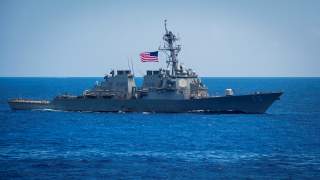Here's How to Avoid War with China
Hint: it's not adopting a more aggressive forward military posture.
On Monday, Taiwanese Defense Minister Yen De-fa stated that, Taiwan would consider allowing a U.S. ship to dock on an island it controls in the volatile South China Sea. Chinese diplomat Li Kexin reportedly warned last year that the day a U.S. ship docked on Taiwan-proper, “is the day China will launch a military attack against Taiwan.”
Before the United States presses its case too strongly in the contested waters near China, a careful analysis of U.S. interests is in order. The volatility of the region has been increasing of late due to statements made by both Beijing and Washington. Vice President Mike Pence recently accused the Chinese of “trying to change the international order in their favor,” and stated, “We will continue to assert American interests across the Indo-Pacific.” Chinese President-for-life Xi Jinping issued his own statement to his troops, proclaiming, “[China] needs to take all complex situations into consideration…[and] step up combat readiness . . . and preparation for war.”
The Chinese military has been building up military forces on islands in the South China Sea. China’s Defense Minister Wei Fenghe said the country would never give up “one single piece” of its territory and warned that “repeated challenges” to its sovereignty over Taiwan were extremely dangerous and would result in military action.
This war of words has led to action within U.S. defense as well. American warships have increased physical patrols ostensibly on freedom of navigation (FON) operations through the volatile Taiwan Straits. This is intended to send a message to China that America will not “back down”—as Vice President Pence said in a speech last month. Back down from what? What Chinese actions warrant a muscular military response?
China is unquestionably a leader in its region and a rising economic power. It has been building up its military to substantial levels for more than two decades. The question for American policymakers, however, is to what end? Does China today represent a rising military power akin to Hitler’s in the mid-1930s? An analysis of military capabilities, force structure, and Chinese actions strongly indicate the answer is in fact “no.”
This is not at all to suggest the People’s Republic of China’s (PRC) Armed Forces aren’t a legitimate and growing military force. However, concerning force structure and capability, Chinese forces are optimized to maintain internal security and defense of their territory. The greatest threat to the Communist regime isn’t the United States or any other external threat but from unrest its 1.4 billion residents. China, therefore, prioritizes the ability to control its population and protect its borders above all.
America’s modern air, sea, and ground power—fleets of transport ships and squadrons of air cargo planes—can deliver and sustain substantial ground combat power almost anywhere on the planet. China does not possess such military capabilities.
China is one of many countries that contests the ownership of various islands in the region, but the disputes have existed for decades, and there is no evidence suggesting the Chinese use of military force to settle the matter. The one glaring example is the situation regarding Taiwanese independence.
Since 1949, Beijing has clung to the belief that Taiwan is a “wayward province” that must one day be reunited with the mainland—and if they ever declare independence, China openly threatens to use military force. Yet, the PRC does not have enough fighting and transport ships, nor sufficient numbers of military aircraft, to support and sustain an invasion of any other country (even those near territorial waters). Beijing currently has but one operational aircraft carrier—and the U.S. military can sink it many times over using sea, air, and land-based assets.
Instead of investing in offensive platforms and capabilities, Beijing has chosen to develop extensive ability to defend its territory and specifically thwart a U.S. attack through anti-access, area-denial (A2AD) capabilities.
According to the 2018 Department of Defense annual report to Congress on Chinese military capabilities, Beijing’s A2AD efforts are defensive and primarily designed to “create an increasingly lethal, multi-access threat against an adversary approaching Chinese waters and operating areas.” In other words, the lion’s share of their military capability is focused on defending their homeland from external aggression, not in enabling it to offensively attack or invade any of its neighbors.
While China is a clear competitor to the United States, it does not represent an offensive threat to America or its treaty allies.
Moreover, China is the world’s second-largest economy and holds enormous upward potential for expanded trade beneficial to the United States. The communist leaders in Beijing are notorious for trying to cheat American business and consumers—and President Trump is right to remain sharply vigilant in defending U.S. economic interests. But it is not in U.S. security interests to maintain an unnecessarily provocative military stance against China in which miscalculation or mistake could result in a military clash. Such an outcome could be catastrophic for American security and economic prosperity.
Daniel L. Davis is a senior fellow for Defense Priorities and a former lieutenant colonel in the U.S. Army who retired in 2015 after twenty-one years, including four combat deployments. Follow him on Twitter at @DanielLDavis1.
Image: Reuters

